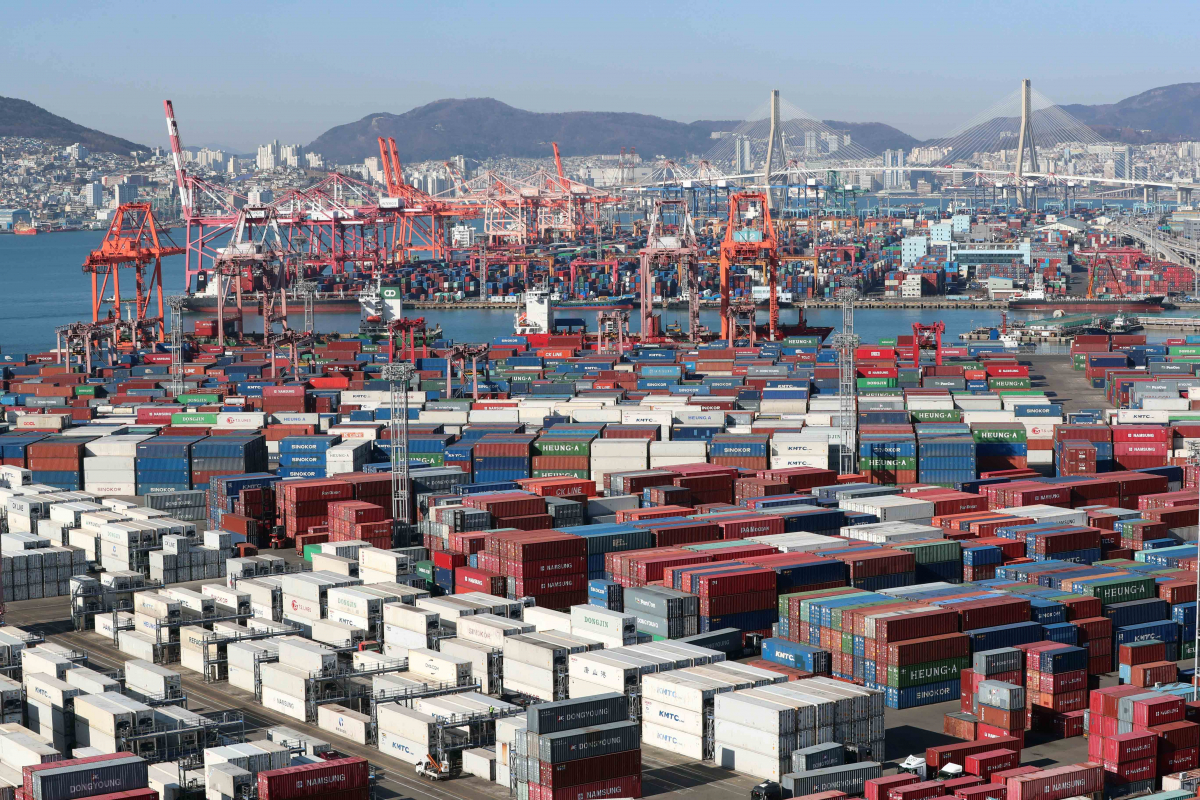▲ Containers are piled up in the yard of Gamman (top) and Sinseondae (bottom), Nam-gu, Busan. (Photo courtesy of Newsis)
Presenting 3% medium-term growth rate of the global economy…the lowest since the publication of WEO
The International Monetary Fund (IMF) has lowered its forecast for Korea’s economic growth this year to 1.5 percent, down 0.2 percentage point (p) from the previous year.
Regarding the medium-term growth rate, which means the global economic growth rate after five years, it presented 3.0%, the lowest since related analysis was announced.
On the 11th (Korean time), the IMF announced in its ‘April World Economic Outlook (WEO)’ that it would “downgrade the global economic growth rate forecast for 2023 to 2.8%, down 0.1%p from the forecast in January this year (2.9%).” revealed
The reason for the downgrade is that there is a high possibility that financial market instability, such as the recent Silicon Valley bankruptcy in the US, will spread to the real market while global economic instability factors such as the Russia-Ukraine war and inflation (inflation), which have continued since last year, have not been resolved.
The projected economic growth rate for this year of the group of developed countries (14 countries), to which Korea belongs, was raised to 1.3%, up 0.1%p from the previous forecast.
However, Korea’s growth rate was lowered by 0.2%p from 1.7% to 1.5%. This is lower than the forecasts previously presented by the government (1.6%), the Bank of Korea (1.6%), the Korea Development Institute (KDI, 1.9%), and the Organization for Economic Cooperation and Development (OECD, 1.6%).
It is analyzed that the continued sharp decline in exports such as semiconductors due to the global economic slowdown served as a factor in the decline in Korea’s growth rate.
The 0.2%p downward revision is the largest after Japan (growth rate of 1.3%, -0.5%p) among major developed countries. Germany (growth rate -0.1%) also showed a downward adjustment of 0.2%p, the same as Korea.
On the other hand, the United States (1.6%, +0.2%p), the United Kingdom (-0.3%, +0.3%p), Italy (0.7%, +0.1%p), and Spain (1.5%, +0.4%p) in January this year. It has been revised up from the forecast.
In the case of China and other emerging and developing countries (155 countries), the previous forecast of 4.0% was lowered by 0.1%p to 3.9%. Russia (0.7%, +0.4%p), Mexico (1.8%, +0.1%p), and Saudi Arabia (3.1%, +0.5%p) were raised, while India (5.9%, -0.2%p) and Brazil ( 0.9%, -0.3%p) were lowered. China (5.2%) maintained the previous forecast.
The International Monetary Fund (IMF) lowered its forecast for next year’s global economic growth rate by 0.1%p from 3.1% to 3.0%. In the case of Korea, it was predicted to be 2.4%, down 0.2% from the previous year.
In particular, the IMF predicted the medium-term growth rate of the world economy (growth rate after five years) at 3.0%. This is the lowest figure since April 1990, when WEO was published.
The IMF evaluated the global economic conditions this year as ‘A Rocky Recovery’. He expressed deep concern over the spread of instability in the financial market, such as the recent Silicon Valley bank and Credit Suisse crisis, due to the Russia-Ukraine war, deepening economic fragmentation, and continued inflation.
In addition, it suggested potential risk factors such as excessively high levels of public and private debt and rising credit spreads in emerging and developing countries.
The IMF advised that it should maintain a tight monetary policy stance until inflation expectations are sufficiently low while strengthening monitoring of financial market instability. In the case of fiscal policy, fiscal austerity is recommended for consistency with monetary policy and debt management, while selective financial support is needed to alleviate the cost of living for the vulnerable.
In the mid- to long-term, it was ordered to manage the fiscal deficit and debt at a sustainable level and to rapidly transition to a low-carbon economic system.
